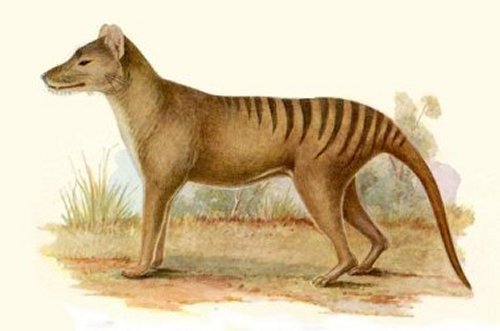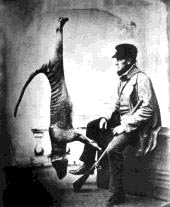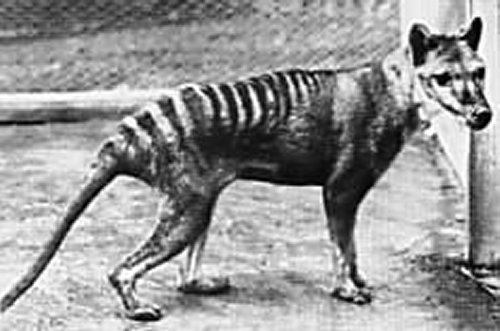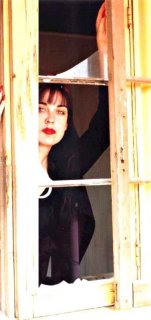THE NATURE OF THE THYLACINE
By Coral Hull

Thylacinus cynocephalus - "The pouched dog with the wolf's head".
Welcome to the first issue of Thylazine; The Australian Journal of Arts, Ethics & Literature.
More than anything, the contents of this e-zine are about the creative artist as an individual animal working in the landscapes or environments within Australia.
The vast majority of Australia's population exists not in the cities as human beings, but as many cultures and species of flora and fauna that span the continent in its entirety. The concept of landscape in Australia, whether it be a physical or psychological entity, conjures feelings of cultural identity and natural history and an overall diversity of lifeforms. From Dreamtime stories, dance, and rituals through to the works of modern day writers, artists, film makers, musicians and photographers, the Australian landscape and our relationship to it as just one of many animals is important, whether we've been to the outback or not.

|
A Thylacine is a "Tasmanian Wolf", and its extinction from this country has affected our psyche to the extent that the animal is still sighted frequently in its old haunts in the Tasmanian wilderness, adorns the rock art of Kakadu and is still considered "endangered" by National Parks and Wildlife.
I will always remember a photo I saw in the Hobart museum of a Thylacine hanging dead from a hook, the disconnected and lifeless shooter beside the dead wolf. I must have stood stunned and did not move until a concerned friend touched my arm. I particularly remember looking through books as a child and the painful experience of seeing the last Australian Thylacine in captivity. It was such a sad and defeated prisoner. I wondered whether it was conscious of being the last one to exist, anywhere. |
There are very few large predatory animals in Australia apart from the now extinct Thylacine and the salt water crocodile in the country's north. In every state and territory animal and plant species are dying out faster than the Field Naturalists can catalogue their existence. The deliberate destruction of this "tasmanian wolf" represents, yet again, the forced submission of a country into the hands of humans without hearts. There is no getting around the fact that Australia has the highest rate of animal extinction in the world since colonisation. Genocide and extinction are what Australia was first built on and they remain part of our history.
A mass extinction always begins and ends with one killing, and that is "the murder of an individual being". It also represents a deep ignorance of what constitutes a landscape and an animal within that landscape, both physically and psychologically. Ever so slowly we are coming to know, that we all suffer somewhere inside ourselves when a culture, or an animal or plant species becomes extinct forever.
But more than its mere vanishing, the Australian Thylacine represents that acute power that occurs when an animal as physical or as spirit moves through and hence becomes a landscape, both in its natural state and as a symbol of what has been. In this way, the stories that are sacred have been told, will be told once again.
Thylazine will focus on Australian artists and writers, photographer and poets, muscians and performers and where and how they work and what they working on throughout this transformational period. I am committed to promoting those Australians who still struggle to maintain their creative art, in these challanging times of little funding and few galleries and publishers. The e-zine will also be a forum for the heroes of environmental and animal rights movement, who have worked so hard for others, for so long. I hope that Thylazine will offer at least some cyber-support and a unique voice for the little-known workers of this country.
Dr. Coral Hull (Editor)

This may be one of the last. "Name us." Lisa Bellear
A special thanks to the contributors; John Anderson, Louis Armand, Lisa Bellear, Judith Beveridge, Rebecca Frederickson, Heather Macleod, Melita Dahl, Michael Farrell, William Fox, Gary L. Francione, Kevin Hart, Coral Hull (that's me), Sandy Jeffs, Ned Johnson, John Kinsella, Mike Ladd, Emma Lew, Cassie Lewis, Patty Mark, Peter Minter, Jenni Mitchell, Mark O'Connor, Sean Poyser, Sarah St Vincent Welch and the many artists and photographers whose work is included in this issue.
And others; The Churchill Northern Studies Centre, Louise Newberry, John Tranter and Mulloka (The Australian Murray Cod) and lastly to Josh, Marla and The Envirolink Network (Pennsylvannia, USA) without whose support and assistance this website would not be possible.
About the Writer Coral Hull

|
Coral Hull was born in Paddington, New South Wales, Australia in 1965. She spent her childhood in Liverpool, on the outer western suburbs of Sydney. Coral is a full-time writer specialising in poetry, experimental prose fiction, scripts and literary articles. Her work has been published extensively in literary magazines in the U.S.A., Canada, Australia and the United Kingdom. She is also the Editor of The Book of Modern Australian Animal Poems, an anthology of Australian poets writing about animals from 1900-1999. Her published books are: In The Dog Box Of Summer in Hot Collation, Penguin Books Australia, 1995, William's Mongrels in The Wild Life, Penguin Books Australia, 1996, Broken Land, Five Islands Press, 1997 and How Do Detectives Make Love?, Penguin Books Australia, 1998.Coral is an animal rights advocate and the Editor of Thylazine, an online literary magazine featuring articles, interviews, photographs and the recent work of Australian artists and writers working in the areas of landscape and animals. She completed a Bachelor of Creative Arts Degree (Creative Writing Major) at the University of Wollongong in 1987, a Master of Arts Degree at Deakin University in 1994, and a Doctor of Creative Arts Degree (Creative Writing Major) at the University of Wollongong in 1998. |
[Above] Photo of Coral Hull by Cliff Hull, 1999.
I Next I
Back I
Exit I
Thylazine No.1 (March, 2000) |



